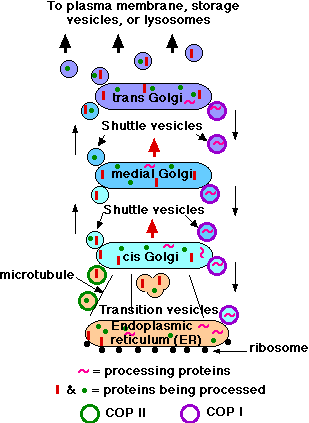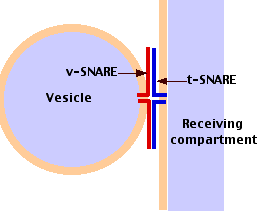The Golgi Apparatus
The Golgi apparatus is a cell structure mainly devoted to processing the proteins synthesized in the endoplasmic reticulum (ER).
The Golgi consists of a stack of membrane-bounded cisternae located between the endoplasmic reticulum and the cell surface.
 Many different enzymes (proteins) are present in the Golgi to perform its various synthetic activities. So there must be mechanisms
Many different enzymes (proteins) are present in the Golgi to perform its various synthetic activities. So there must be mechanisms
- to sort out the processed proteins and send them on to their destinations while
- reclaiming processing proteins (e.g., glycosylases) for reuse.
All the details are far from worked out, but these are some of the features for which there is considerable experimental evidence.
The Outbound Path
- Transition vesicles pinch off from the surface of the endoplasmic reticulum carrying
- integral membrane proteins
- soluble proteins awaiting processing
- processing enzymes
- Pinching off requires that the vesicle be coated with COPII (Coat Protein II)
- The transition vesicles move toward the cis Golgi on microtubules.
- As they do so, their COPII coat is removed and they may fuse together forming larger vesicles.
- These fuse with the cis Golgi
- Sugars are added to proteins in small packets so many glycoproteins have to undergo a large number of sequential steps of glycosylation, each requiring its own enzymes.
- These steps take place as shuttle vesicles carry the proteins from cis to medial to the trans Golgi compartments.
- At the outer face of the trans Golgi, vesicles pinch off and carry their completed products to their various destinations.
The Inbound Path
The movement of cisternal contents through the stack means that essential processing enzymes are also moving away from their proper site of action.
Using a variety of signals, the Golgi separates the products from the processing enzymes that made them and returns the enzymes back to the endoplasmic reticulum.
This transport is also done by pinching off vesicles, but the inbound vesicles are coated with COPI (coat protein I)
How does a vesicle recognize its correct target?
 This involves pairs of complementary integral membrane proteins
This involves pairs of complementary integral membrane proteins
- v-SNAREs = "vesicle SNAREs" — on the vesicle surface;
- t-SNAREs = "target SNAREs" — on the surface of the target membrane.
v-SNAREs and t-SNAREs bind specifically to each other thanks to the complementary structure of their surface domains.
Binding is followed by fusion of the two membranes.
Another mechanism of Golgi traffic?
There is some evidence that in addition to the pinching off and fusing of shuttle vesicles, the cisternae of the Golgi actually migrate themselves; that is, the cis Golgi gradually migrates up the stack becoming a medial and finally a trans Golgi (depicted in the top figure with red arrows).
The Golgi is not a static cell organelle
- The Golgi breaks up and disappears at the onset of mitosis.
- By telophase of mitosis, the Golgi reappears. How it is recreated is still uncertain.
20 October 2005
 Many different enzymes (proteins) are present in the Golgi to perform its various synthetic activities. So there must be mechanisms
Many different enzymes (proteins) are present in the Golgi to perform its various synthetic activities. So there must be mechanisms
 This involves pairs of complementary integral membrane proteins
This involves pairs of complementary integral membrane proteins